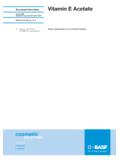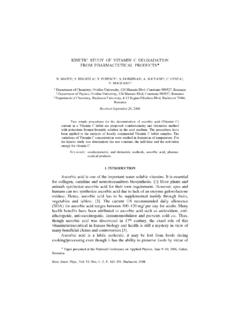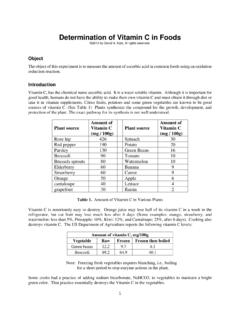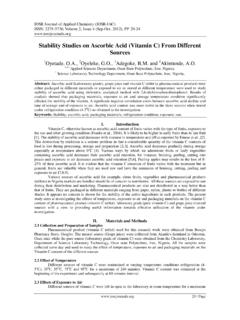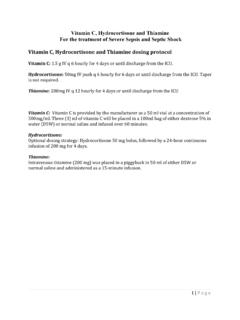Transcription of Technical Information Phosphate
1 Hair Care Skin Care Oral CareTechnical InformationJuly 2005 Supersedes issue dated May 2005 MEMC 050423e-00/Page 1 of 24 sodium ascorbyl Phosphate = Registered trademark of BASF AktiengesellschaftActive ingredient for the cosmetics industry. Acts as an in-vivo antioxidant, promotes collagen formation, lightens the skin. MEMC 050423e-00 July 2005 Page 2 of 24 sodium ascorbyl PhosphateStruc tu ral for mula Synonym L-ascorbic acid-2-monophosphate, trisodium saltMolecular formula C6H609Na3 PMolar mass g/molINCI name sodium ascorbyl PhosphateCAS-No. 66170-10-3 Description sodium ascorbyl Phosphate is a stable vitamin C derivative.
2 The product is a white to pale beige powder with practically no odor. Specifi cationParameter Requirement Method Purity min. 95% 05 vitamin C content min. 05 Identity Passes test 05 Solubility (10% in water) Solution is clear -Water Max.
3 11% 05 pH value (3% in water) 9-10 05 Heavy metals max. 20 ppm 05 Arsenic max. 2 ppm 05 Application sodium ascorbyl Phosphate is an active ingredient for sophisticated cosmetic skin-care products. It is a stable vitamin C derivative. It protects the skin, promotes its development and improves its ascorbyl Phosphate is cleaved enzymatically in the skin to release active vitamin C. sodium ascorbyl Phosphate is therefore an effective antioxidant which protects the cells against damage caused by free radicals.
4 sodium ascorbyl Phosphate counteracts skin aging in promoting collagen formation. sodium ascorbyl Phosphate also acts on the melanine formation process to prevent hyperpigmentation and senile keratosis. It therefore has skin lightening properties. Because of its wide spectrum of action, sodium ascorbyl Phosphate is suitable for use in a wide range of skin care products. As an effective watersoluble anti-oxidant which is stable in cosmetic formulation it is the perfect completion to vitamin E Acetate, which is the common oil-soluble equivalent. The oilsoluble vitamin E Acetate together with the water-soluble sodium ascorbyl Phosphate are the perfect anti-oxidant system in all skin-care formulations which are used against the daily environmental stress for the skin.
5 Other very important areas of use are sun protection formulations, antiwrinkle products, body lotions, day creams and night creams, and whitening 050423e-00 July 2005 Page 3 of 24 sodium ascorbyl PhosphateRecommended concentrations sodium ascorbyl PhosphateDaily skin care care products products >3%Solubility It is possible to prepare solutions of up to 64% in water, in glycerol and in propylene glycol with sodium ascorbyl Phosphate . It is practically insoluble in ethanol, isopropyl myristate, cetostearyl octanoate, caprylic/capric triglyceride and C12-15 alkyl The product should be stored and transported in the original sealed containers, protected from light and moisture, at temperatures below 25 C.
6 Contact with metals should be avoided. The product is stable for at least 24 months if stored in the original sealed containers at 25 in water and cosmetic formuationsSodium ascorbyl Phosphate is far more stable than Ascorbic Acid in water. Stability of sodium ascorbyl Phosphate and ascorbic acid in 3% solutions in water at 40 C and pH 6: sodium ascorbyl Phosphate is stable in a wide range of formulations (see typical formulations). Stability of sodium ascorbyl Phosphate in different formulations (see typical formulations) at 20 C, pH : When the formulations were kept at 40 C, they became discoloured after about 2 months, and assumed a pale beige colour.
7 Finished products should therefore be stored at temperatures below 25 050423e-00 July 2005 Page 4 of 24 sodium ascorbyl Phosphate Stability of sodium ascorbyl Phosphate in different formulations at 40 C, pH : The stability of the product depends very much on the pH value of the formulation. The best stability is obtained at pH values above Stability of sodium ascorbyl Phosphate 3% in water at different pH values at 40 C: MEMC 050423e-00 July 2005 Page 5 of 24 sodium ascorbyl Phosphate Stability of sodium ascorbyl Phosphate approx. 1% in formulation 62/00082 NDE at different pH values at 20 C: Technical propertiesand handlingSodium ascorbyl Phosphate is a crystalline solid that is sensitive to heat, moisture, low pH values and heavy the production of cosmetic care products, it is recommended to add sodium ascorbyl Phosphate to formulations at a low temperature ( <40 C).
8 It can be exposed to higher temperatures up to 80 C, but only for a short product is most stable above pH It is recommended to use a buffer system and to add a chelating agent. Finished formulations should be stored at a temperature below 25 Data Sheet A Safety Data Sheet is available for sodium ascorbyl Phosphate . It contains the main results of the toxicological activity and Synergy with vitamin E: Results of in-vitro studyIntroductionThis study is able to show the synergistic action of vitamin E and vitamin C working together as anti-oxidants in the human human keratinocytes (HaCaT cells) were chosen as an in-vitro model.
9 Due to the reduced stability of Tocopherol ( vitamin E) and Ascorbic Acid ( vitamin C) in cosmetic formulations pro-drugs are used, typically vitamin E Acetate and sodium ascorbyl Phosphate , respectively. They were therefore used in this in-vitro cell test. The HaCaT-cell system contains the esterases and phosphatases needed to convert the pro-drugs into the active form. sodium ascorbyl Phosphate is water soluble and can be used as such in this aqueous cell system. vitamin E Acetate is insoluble in water and has to be brought into solution with a vehicle. To keep the conditions as simple as possible, ethanol was used as vehicle.
10 vitamin E Acetate was dissolved in ethanol. A control experiment ensured that the vehicle ( ethanol solution in water) has no disturbing effect. Due to different kinetics of the cleavage of the prodrug into the active form, the optimum reaction time had to be determined empirically in preliminary experiments. It could be shown that a reaction time of 48 hrs. for sodium ascorbyl Phosphate and 7 days for vitamin E Acetate are the ideal conditions. (The compounds are stable in water during this time.) If a combination was tested, vitamin E Acetate supplementation started 5 days before adding sodium ascorbyl Phosphate .
